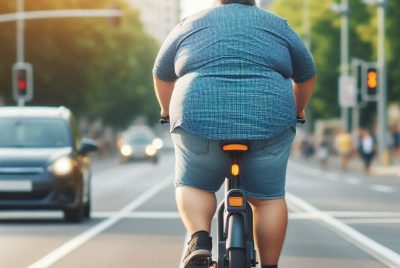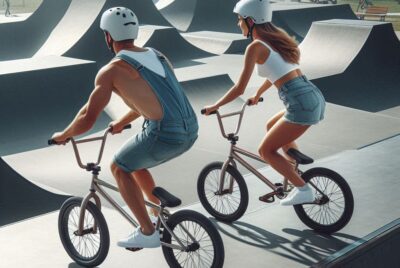Track Bikes: Unleashing the Velodrome Thrill
*We may earn a commission for purchases made using our links. Please see our disclosure to learn more.
Track Bikes: The Ultimate Guide to High-Speed Cycling
Track bikes are unique and fascinating machines designed specifically for racing on velodromes. Built for speed and precision, these bikes feature a simple yet effective design that facilitates amazing aero efficiency. With no gears and often no brakes, they offer an unparalleled direct connection between rider and machine, making every pedal stroke count.

What makes track bikes particularly interesting is their specialized construction. Frames are typically lightweight and rigid to enhance speed and control. The wheels are often either clincher or tubular box rim spoked wheels, chosen for their balance of performance and affordability. These elements, combined with the streamlined frame, contribute to the high speeds achieved in track cycling events.
Track bikes belong to one of the oldest and most prestigious disciplines in cycling. Riders compete in various formats, racing at breathtaking speeds that can reach up to 50 mph. If you’re a cycling enthusiast looking to understand the nuances of track bikes or considering venturing into a new cycling discipline, exploring these high-performance machines is a great start. From their history to their design, track bikes offer a unique insight into the world of competitive cycling.
History and Evolution of Track Bikes

Track bikes have a rich history intertwined with technological advancements. The materials and designs have evolved significantly over the years, impacting how world records are set and broken.
From Steel to Carbon
Early track bikes were made from steel, specifically cromoly steel, which was strong yet relatively light for its time. These bikes were simple and rugged, ideal for the rough conditions of early velodrome racing.
In the 1980s, bikes started to incorporate aluminium, which was lighter than steel and didn’t rust. This change made the bikes faster and more agile.
Today, manufacturers make most high-performance track bikes from carbon fiber. This material is extremely light and can be molded into aerodynamic shapes, giving riders a significant edge in speed and handling. While some bikes use titanium, competitive cyclists still prefer carbon.
Innovation and World Records
Innovation in track bike technology has always been driven by the quest to break world records. One notable milestone was in 2015, when Bradley Wiggins rode a Pinarello track bike to set a new hour record.
The introduction of the fixed-gear system is another key innovation. These bikes have no freewheel or brakes, meaning the rider has direct control over the bike’s speed and acceleration.
Aerodynamic advancements have also played a big role. Narrow tires, high-pressure inflation, and streamlined frames reduce drag and maximize speed. Modern track bikes allow world champions to push the boundaries of human performance, setting new records and achieving remarkable feats in velodrome cycling.
Track Bikes: Anatomy and Design

Track bikes are designed to perform exceptionally on velodromes, featuring unique frame geometry and materials to enhance speed and stability. Aerodynamics play a crucial role in track cycling, as these bikes are built to reduce air resistance and maximize efficiency.
Frame Geometry and Materials
Track bike frames are designed with a steep geometry, featuring steep angles for the head tube and seat tube. This geometry allows for a more aggressive riding position, which is essential for maintaining high speeds.
Frame materials are typically lightweight and stiff. Carbon fiber is popular due to its high strength-to-weight ratio, while aluminum is favored for its affordability and durability. The bottom bracket is placed high to prevent pedal strikes during banking.
These bikes also have a short top tube for better handling and a tight rear triangle for increased stiffness. The handlebars are drop-style, allowing riders to maintain an aerodynamic position. Cranks and pedals are robust for power transfer, and the chainring and cog are often customized for optimal gear ratios.
Importance of Aerodynamics
Aerodynamics is a critical aspect in track bike design. The frame and components are shaped to cut through the air efficiently. Aero features include tapered tubes, smooth transitions, and hidden cables.
Wheels are often deep-section or disc type to minimize drag. The rider’s body position is low and forward to reduce frontal area. Handlebar design, often with extensions, helps maintain this posture.
Every component, from the handlebars to the chainring, is optimized to reduce air resistance. Attention to detail in aerodynamics allows track cyclists to maintain higher speeds with less effort, making it a fundamental consideration in both bike design and racing strategy.
Gear and Setup of Track Bikes

Track bikes are specially designed for racing on a velodrome. These bikes use a fixed-gear mechanism and specific gear ratios to optimize speed and performance.
Fixed-Gear Mechanism
Track bikes feature a fixed-gear system, directly linking the pedals and the rear wheel. When the wheel moves, the pedals move too. This setup doesn’t allow coasting.
The bike’s simplicity means fewer parts like no derailleurs or shifters. This reduces weight and maintenance. Most track bikes have a spoked front wheel for better handling and a disc wheel in the rear for improved aerodynamics.
Gear Ratios and Speed Optimization
Choosing the right gear ratio is vital for track cycling. A smaller cog in the back and a larger chainring in the front result in higher speeds but require more force.
Riders often test different ratios to find the best match for their strength and event type. Using the right gear ratio helps in maintaining speed and maximizing performance during a race. Tires also play a role; they are usually narrow and smooth for minimal resistance.
Track Bikes: Racing and Strategies on the Velodrome

On the velodrome, speed and precision are key. Track cyclists use unique strategies depending on the type of race. Each race has different demands and requires specific skills.
Sprint and Pursuit Disciplines
In the velodrome, sprint races focus on explosive power and acceleration. Sprints usually involve a few laps where riders jockey for position, then an all-out sprint to the finish line. I must master timing and positioning to make decisive moves and outmaneuver my rivals.
Pursuit races are more about sustained speed and endurance. Here, two cyclists start on opposite sides of the velodrome and try to catch each other. Pacing is crucial in pursuit races. I need to balance my speed so I don’t burn out too soon, while also pushing hard enough to close the gap on my opponent.
Endurance Events: Madison and Omnium
Endurance events, such as the Madison and Omnium, test stamina and strategy. The Madison race involves pairs of riders who take turns racing and resting. Teams must have seamless handoffs, known as “Madison slings,” to maintain speed. Coordination with my partner is vital to keep a competitive edge.
The Omnium is a multi-race event that includes different race types like sprints, time trials, and endurance races. Consistency is crucial in the Omnium. I must perform well across various disciplines to accumulate the most points and achieve victory.
By understanding and mastering these racing styles and strategies, I improve my chances of excelling on the velodrome. Success in track racing comes from a mix of speed, endurance, and tactical acumen.
Track Bikes: Rules and Regulations of Track Cycling

When riding a track bike in competitive events, there are specific rules to follow to ensure fairness and safety.
Aerodynamics plays a crucial role. Riders use streamlined helmets and skinsuits to reduce wind resistance.
Tracks, or velodromes, are specially designed with steeply banked turns. They must meet certain specifications for length and surface type to reduce rolling resistance.
In time trial events, riders aim to complete the distance in the shortest time possible. Precise measurement of the course and consistent starting procedures are essential.
Teams like Team GB follow strict guidelines during relay events. Each cyclist must exchange within a marked zone.
Equipment rules are also very strict. Track cyclists ride bikes without brakes and with a fixed gear, so the pedals are directly linked to the rear wheel.
Anti-doping policies enforced by organizations such as UCI ensure all competitors have an equal playing field.
Lastly, race permits and the role of race directors are vital. They coordinate the event, ensuring all participants adhere to the official rules.
Adhering to these rules ensures that track cycling remains a fair and thrilling sport for everyone involved.
Selecting and Maintaining Track Bikes
Choosing the right track bike involves considering the bike’s frame, gear ratio, and handling characteristics. Maintenance and safety tips ensure the bike performs well and remains safe to ride.
Choosing the Right Track Bike
When selecting a track bike, I first look at the frame. Track bike frames are lightweight and rigid, designed for speed and stiffness. The geometry is very tight, which helps with quick handling and precision on the velodrome. The gears are fixed, meaning there’s no coasting.
Common gear sizes on track bikes range between 84 to 90 inches. This ensures optimal power transfer and performance. I also pay attention to components like the chainring and sprocket sizes, as well as the wheel setup. Many high-performance track bikes come with disc wheels, which enhance aerodynamics.
Maintenance and Safety Tips
Maintaining a track bike requires regular checks and adjustments. I always inspect the chain for wear and lubrication, ensuring smooth function. Keeping the chain clean and well-lubricated is key to avoiding premature wear.
I also check the brakes and tires frequently. Though track bikes often lack traditional brakes, the tires need to be in great condition to maintain grip and safety, especially on a banked track. Additionally, inspecting the frame for cracks or damage ensures the bike remains safe to ride.
Safety gear, like a helmet and proper cycling shoes, is crucial. I always wear protective gear to minimize injury risk while riding. Regular maintenance, combined with the right safety precautions, keeps the bike in top condition and ensures a safe, enjoyable ride.
FAQs About Track Bikes
Let’s explore some common questions about track bikes, focusing on key features, competitive racing, sizing, legality on public roads, top brands, and where to find used bikes.
1. What are the distinctive features of a track bike compared to a standard bicycle?
Track bikes are designed for racing on velodrome tracks. They usually have a fixed gear, no brakes, and a rigid frame. This setup allows for high speeds and precise control. Unlike standard bicycles, they often have minimalist designs focused on performance and aerodynamics.
2. What considerations should one keep in mind when choosing a track bike for competitive racing?
When choosing a track bike for competitive racing, it’s important to consider the bike’s weight, aerodynamics, and stiffness. High-quality materials like carbon fiber or aluminum are preferred. Wheel choices are also crucial, with many opting for spoked wheels during training and disc wheels for races to reduce drag.
3. How does one determine the appropriate sizing for a track bike frame?
The appropriate sizing for a track bike frame depends on your height and inseam measurement. Many bike shops and online calculators can provide sizing recommendations. It’s essential to test ride different sizes as well to ensure the best fit for your body and riding style.
4. Can track bikes be used legally on public roads and what modifications are required if so?
Track bikes can be used on public roads, but they require modifications. At a minimum, you must add brakes as track bikes typically do not have them. Also, reflectors and lights are necessary for safety and to meet legal requirements in many areas.
5. What are the top brands in the track bike market known for quality and performance?
Top brands in the track bike market include Specialized, Trek, Cervélo, and Dolan. People know these brands for their high-quality materials, advanced engineering, and consistent performance in competitive racing. Investing in a bike from one of these brands can provide a reliable and competitive edge.




